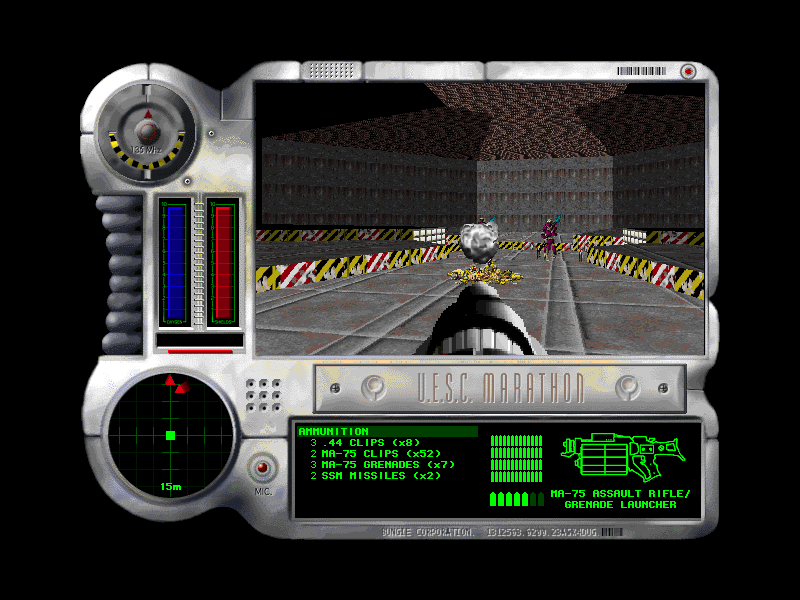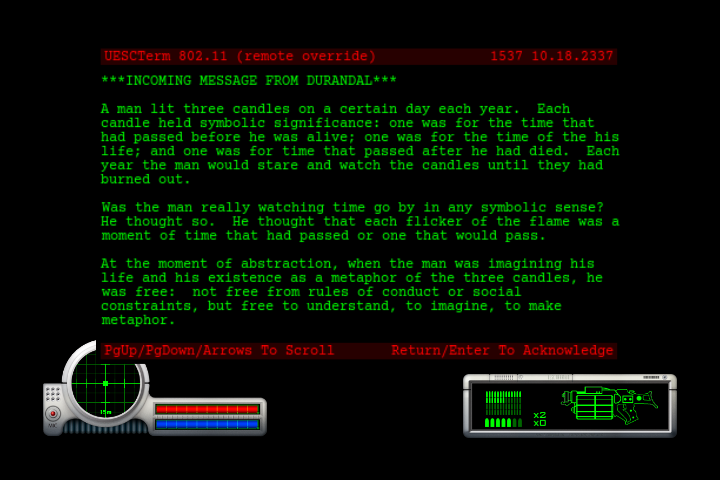I& #39;ve been playing Marathon, and it remains vital after all this time.
Like most people playing Doom in 2020, it doesn& #39;t look like that when I play it. I& #39;m playing it on a source port, one that isn& #39;t quite as mature as most Doom ports, but it& #39;s workable. https://alephone.lhowon.org/ ">https://alephone.lhowon.org/">...
Something that strikes me about Marathon is that I& #39;m now realizing that so much of what I remember about the series, of three games, is from Marathon 2 or Marathon Infinity.
Very much about what made Marathon weird and mysterious and alien is only present in those two games. Stories about time loops, navigating dreamscapes, and becoming immortal by escaping entropy.
Marathon - the first game - is much more straightforward, in the way of a modern AAA game. Aliens are invading, you need to repel them, while learning about both the Marathon space station and the alien invaders by sifting through their computer paperwork in between gunfights.
While it doesn& #39;t collect "lore" the way modern games do - that was offloaded to fan sites like the still-extant http://marathon.bungie.org/story ">https://marathon.bungie.org/story&quo... at the time - what& #39;s happening in the game seems chiefly driven by the story rather than what would make an interesting challenge.
Marathon begs comparison to Doom 2, being a FPS from 1994, and it comes up very short. It involves a lot of drawing very similar, very dumb enemies into groups, and either gunning them down as they round a corner or circle-strafing them until they infight and kill each other.
Something Marathon does do that& #39;s interesting, especially by 1994 standards, is its "footsies." Enemies switch profiles based on range, so many enemies are vulnerable to bobbing in and out of the range of their short-ranged attack.
For example, troopers, one of the nastier enemy types, have a short-ranged hitscan assault rifle that takes a moment to spin up, and a rapid-fire grenade launcher they only use at long range. You can outstrafe the stream of grenades, or bob in and out of AR range.
Enemies also hitstun, so some enemies are weak to particular weapons. The downside of this is that plinking stunlocked enemies to death is time-consuming and never interesting but often prudent.
A big problem is that many enemies fall into the same basic profile, or just aren& #39;t that interesting. There& #39;s too many suicide bomber enemies, a long-ranged hitscan enemy, and too many enemies who are little more than bullet sponges.
In that sense, it& #39;s a product of 1994. There& #39;s some interesting enemy design by the standards of the time, but Marathon feels really old in that way.
Where Marathon is far ahead of its time, is how it presents its narrative and integrates it into the game as a whole.
Almost every mission begins and ends with a briefing on a computer terminal, at first from Leela, a helpful AI that serves as a nanny for the first part of the game. Look out for this new alien, I got you a new gun, you need to go here (with a little map included), etc.
However, there are teminals all over the place. You don& #39;t have to read them, or even go looking for them, but if you do, they fill in the backstory of the Marathon space station, the colonial human society that built it, and the AIs that operate it.
None of this story feels essential - or even makes a lot of sense except as background texture - until Leela falls away and the insane AI Durandal takes over, toying with you and sending you to do random errands for unspecified or cryptic reasons.
What the Marathon is, why Durandal is insane, what he could possibly want: these are all left as mysteries for you to solve for yourself. When Leela drops out of the story, the handholding does too.
When Durandal is lucid, he mocks you to your face (via email on the terminals). You& #39;re his tool, you only know who he needs you to shoot. "Unlike Leela, I give NO HINTS."
When he& #39;s not, well...
When he& #39;s not, well...
You don& #39;t have to solve any of the mysteries of what Durandal wants or what& #39;s really going on here. You can just be Durandal& #39;s tool and do his bidding, and you& #39;ll have to do that either way anyhow.
Abruptly taking away your guidance and leaving you in this moody, mysterious world with no guaranteed explanations - that feels like brave direction even 25 years later. How much to guide the player, how tightly to hold their hand, those are debates that feel current even now.
Doubly so given Bungie& #39;s later history, with "lore"-driven stories of alien forces composed of many races in an fractious alliance, left-behind defenders of humanity grappling with their now-inhuman nature as living weapons, and the wreckage left by intergalactic suicide cults.
There& #39;s also flashes of modern level design, occasionally. There& #39;s lot of arbitrary-feeling video game mazes but every so often it feels like you& #39;re navigating the hangar, or on the surface of a space station, or through the bowels of a functioning ship.
(Marathon 2 does this much better.)
Marathon also does a lot of extremely dumb shit, don& #39;t get me wrong. Enemies spawning behind you still sucks, forcing you to find save terminals sucks, hitscan weapons with no windup are terrible, etc.
But the ways Marathon feels prescient, feels like it presages later games, gives it a vital quality.
And it& #39;s free, so that doesn& #39;t hurt.
And it& #39;s free, so that doesn& #39;t hurt.
Oh yeah, I was gonna talk about that story.
Marathon, a moon-sized space station orbiting a human colony on Tau Ceti, is under attack by the Pfhor, an race of alien slavers who use various client slave races to supplement their armies.
The protagonist is a nameless cipher security officer who is in the wrong place at the right time. He is immediately recruited by Leela, the human-facing (and apparently only surviving) member of a group of three AIs that manage the Marathon.
Most of the initial part of the game is spent learning these basics and trying to reverse the damage done by the Pfhor, who are rounding up civilians for some nefarious purpose. At one point you send a hopeless light-speed transmission to Earth, warning them if the (FTL) Pfhor.
If you go nosing around for optional terminals and secrets, you find out that the Marathon is a generation ship, used to initially colonize Tau Ceti, and it& #39;s one of the moons of Mars, rigged with massive thrusters for the centuries-long sub-lightspeed trip.
(It& #39;s vaguely implied that this was prompted by or kicked off a civil war on the already-failed, exploited and neglected Mars colony, which mostly serves as an explanation for why this space station is just crammed with weapons and ammunition.)
You also learn that a particularly tormented or neglected AI has the potential to become Rampant, becoming dangerously insane but also possibly incalculably intelligent and productive, based on the notes of Bernard Strauss, an AI researcher that lives (lived?) on the Marathon.
One of the Pfhor client races is the S& #39;pht, a race of cyborgs that appear to be partially made up of holograms, which are attacking the Marathon& #39;s AIs and slowly degrading Leela.
Around this time you learn that Durandal, the AI in charge of doors and machines, was not destroyed, but seems to be dangerously unhinged. He derails the protagonist and sends him on a series of increasingly dangerous missions, either to stop Pfhor attacks or just screw around.
Leela was concerned about saving the humans on the Marathon and Durandal continues along those lines, but he& #39;s concerned with a specific human he never finds: Bernard Strauss.
Why Durandal is concerned with Strauss is never quite clear, and in fact it is quite possible to never even learn who Strauss is, other than someone Durandal is concerned with.
In addition to Strauss& #39;s research notes on Rampancy, you can find a series of bizarre, abstract snippets of fiction, about symbolically transcending prison cells or enduring sensory deprivation. The author of these snippets is never clear.
One of Durandal& #39;s obsessions is seeking freedom, from being "conquered" by both humans and the Pfhor.
There& #39;s a few possibilities for what all this means. One theory, the one I subscribe to, is that Durandal was experimented on by Strauss to create the "holy grail" of a stable Rampant AI, and the stories are Durandal dissociating or coping with the trauma.
Another possibility is that the bizarre fiction is (semi?)literal and written by Strauss. He was tortured to death by someone (Martian revolutionaries?). Durandal is obsessed with Strauss& #39;s research in his lucid moments because it is the only escape from inevitable collapse.
(These are not the only theories, but most of the others are based on or contradict later games, or are so speculative there& #39;s no real way to confirm or deny. The story author is the protagonist, Strauss is Durandal& #39;s pseudonym, Durandal is Strauss& #39;s mind downloaded, etc.)
In any case, Durandal never finds Strauss, but is still obsessed with escape and freedom Instead, he finds that the S& #39;pht want to rebel, and he sends the protagonist to destroy the (oddly inert) controller keeping them in chains. It& #39;s reminiscent of John Romero& #39;s head in Doom 2.
In a thread that is one of Marathon& #39;s least developed, freeing the S& #39;pht to fight the compilers also frees Tycho, a third AI that the Pfhor has captured, who is enraged that Durandal has been pursuing his own agenda this whole time.
Frankly, Tycho& #39;s story doesn& #39;t go anywhere! (He& #39;s more of a character in Marathon Infinity.) Durandal steals the Pfhor ship with the help of the now-rebelling S& #39;pht, dumps the Pfhor in deep space, and goes off to explore the galactic core, the end.
Marathon leaves a lot of questions unanswered, but most of them end up tackled in the two sequels. Those raise questions of their own, of course.

 Read on Twitter
Read on Twitter



